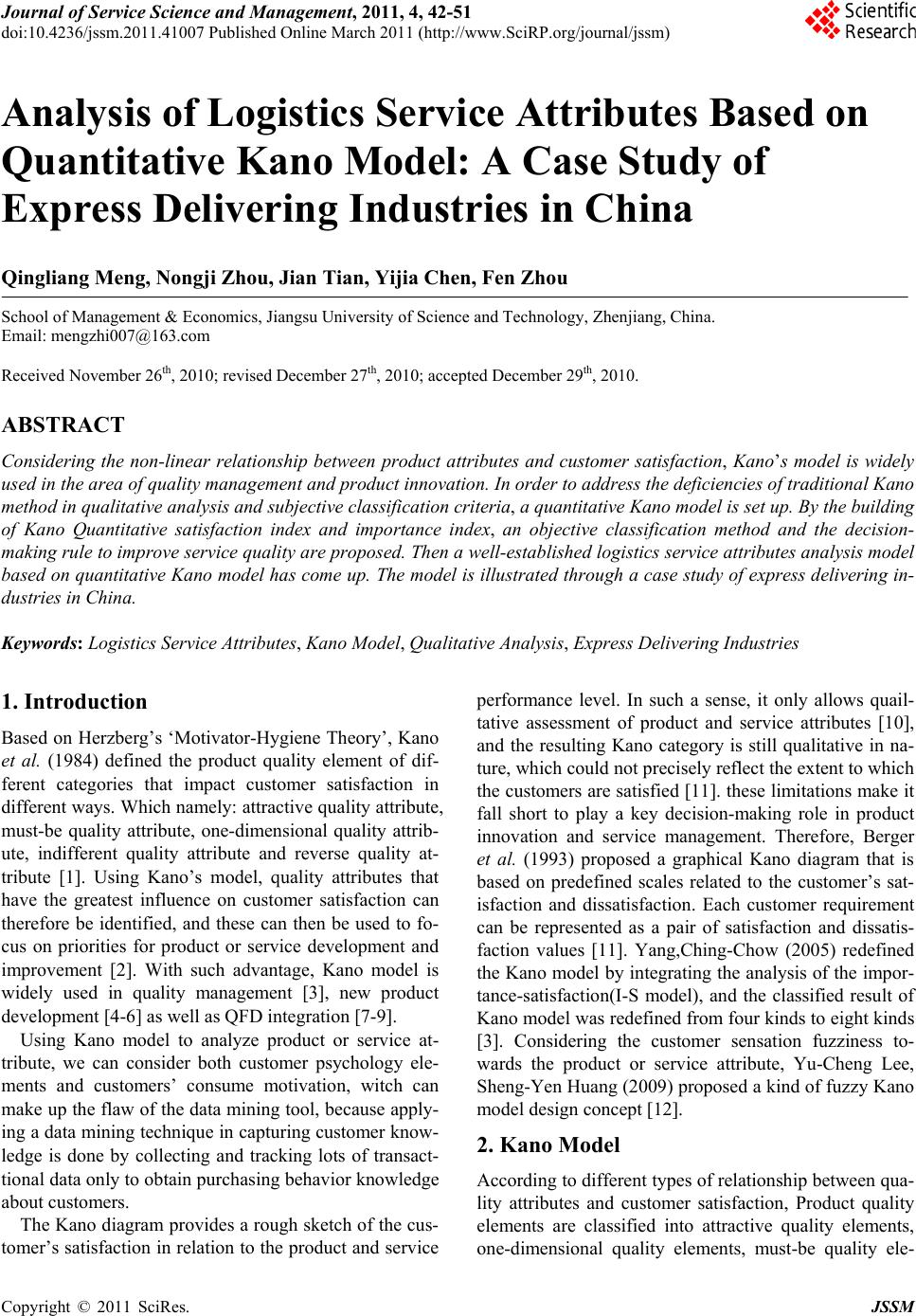 Journal of Service Science and Management, 2011, 4, 42-51 doi:10.4236/jssm.2011.41007 Published Online March 2011 (http://www.SciRP.org/journal/jssm) Copyright © 2011 SciRes. JSSM Analysis of Logistics Service Attributes Based on Quantitative Kano Model: A Case Study of Express Delivering Industries in China Qingliang Meng, Nongji Zhou, Jian Tian, Yijia Chen, Fen Zhou School of Management & Economics, Jiangsu University of Science and Technology, Zhenjiang, China. Email: mengzhi007@163.com Received November 26th, 2010; revised December 27th, 2010; accepted December 29th, 2010. ABSTRACT Considering the non-linear relationship between product attributes and customer satisfaction, Kano’s model is widely used in the area of qua lity man agem ent and produ ct inno vation . In order to add ress th e deficiencies o f trad itiona l Kano method in qualitative analysis and subjective classifica tion criteria, a quantitative Kano model is set up. By the building of Kano Quantitative satisfaction index and importance index, an objective classification method and the decision- making rule to improve service q uality are pro posed . Then a well-estab lished logistics service attrib utes analysis model based on quantitative Kano model has come up. The model is illustrated through a ca se study of express delivering in- dustries in China. Keywords: Logistics Service Attributes, Kano Model, Qualitative Analysis, Express Deliverin g Industries 1. Introduction Based on Herzberg’s ‘Motivator-Hygiene Theory’, Kano et al. (1984) defined the product quality element of dif- ferent categories that impact customer satisfaction in different ways. Which namely: attractive quality attribute, must-be quality attribute, one-dimensional quality attrib- ute, indifferent quality attribute and reverse quality at- tribute [1]. Using Kano’s model, quality attributes that have the greatest influence on customer satisfaction can therefore be identified, and these can then be used to fo- cus on priorities for product or service development and improvement [2]. With such advantage, Kano model is widely used in quality management [3], new product development [4-6] as well as QFD integration [7-9]. Using Kano model to analyze product or service at- tribute, we can consider both customer psychology ele- ments and customers’ consume motivation, witch can make up the flaw of the data mining tool, because apply- ing a data mining technique in capturing customer know- ledge is done by collecting and tracking lots of transact- tional data only to obtain purchasing behavior knowledge about customers. The Kano diagram provides a rough sketch of the cus- tomer’s satisfaction in relation to the product and service performance level. In such a sense, it only allows quail- tative assessment of product and service attributes [10], and the resulting Kano category is still qualitative in na- ture, which could not precisely reflect the extent to which the customers are satisfied [11]. these limitations make it fall short to play a key decision-making role in product innovation and service management. Therefore, Berger et al. (1993) proposed a graphical Kano diagram that is based on predefined scales related to the customer’s sat- isfaction and dissatisfaction. Each customer requirement can be represented as a pair of satisfaction and dissatis- faction values [11]. Yang,Ching-Chow (2005) redefined the Kano model by integrating the analysis of the impor- tance-satisfaction(I-S model), and the classified result of Kano model was redefined from four kinds to eight kinds [3]. Considering the customer sensation fuzziness to- wards the product or service attribute, Yu-Cheng Lee, Sheng-Yen Huang (2009) proposed a kind of fuzzy Kano model design concept [12]. 2. Kano Model According to different types of relationship between qua- lity attributes and customer satisfaction, Product quality elements are classified into attractive quality elements, one-dimensional quality elements, must-be quality ele- 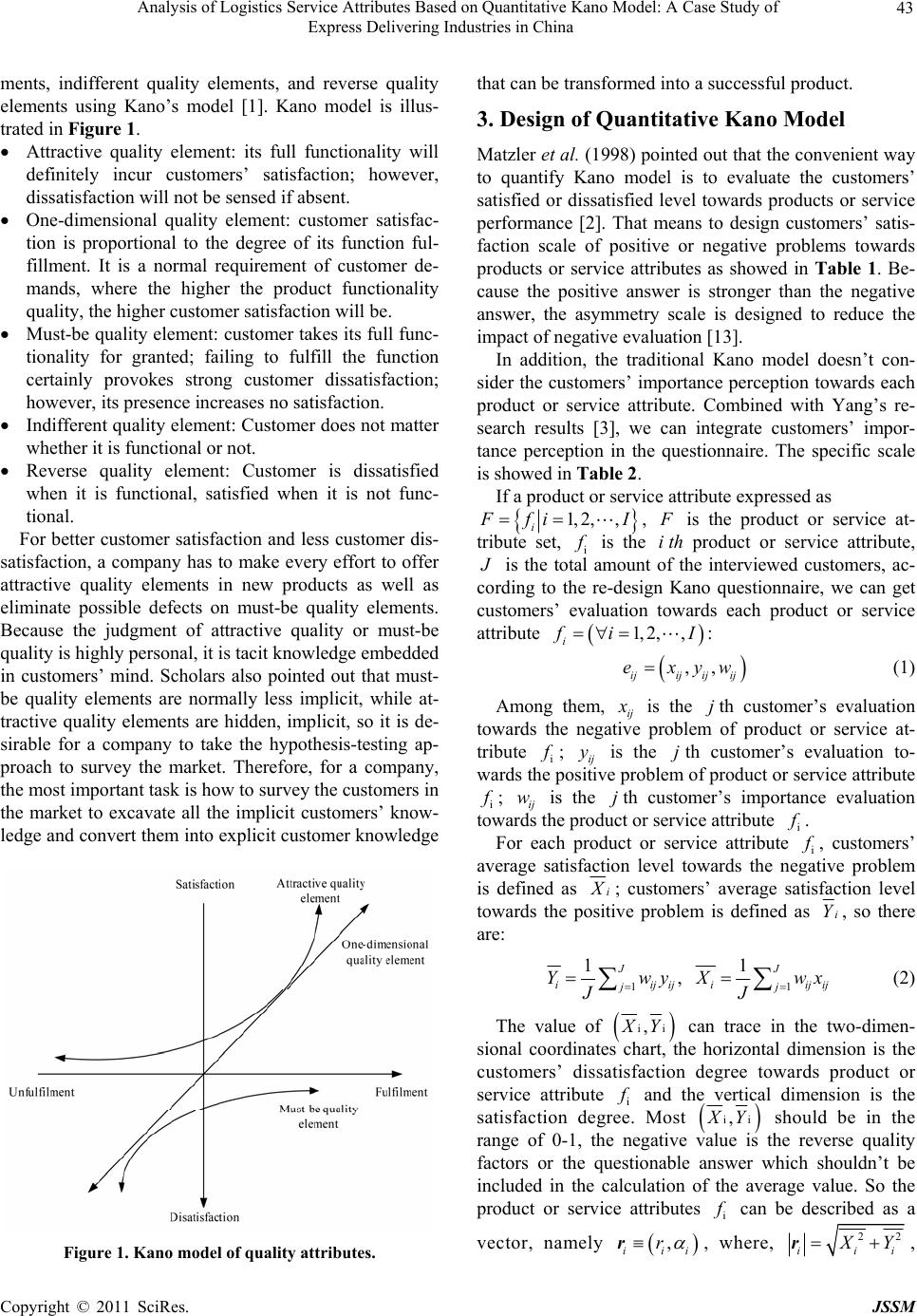 Analysis of Logistics Service Attributes Based on Quantitative Kano Model: A Case Study of Express Delivering Industries in China 43 ments, indifferent quality elements, and reverse quality elements using Kano’s model [1]. Kano model is illus- trated in Figure 1. Attractive quality element: its full functionality will definitely incur customers’ satisfaction; however, dissatisfaction will not be sensed if absent. One-dimensional quality element: customer satisfac- tion is proportional to the degree of its function ful- fillment. It is a normal requirement of customer de- mands, where the higher the product functionality quality, the higher customer satisfaction will be. Must-be quality element: customer takes its full func- tionality for granted; failing to fulfill the function certainly provokes strong customer dissatisfaction; however, its presence increases no satisfaction. Indifferent quality element: Customer does not matter whether it is functional or not. Reverse quality element: Customer is dissatisfied when it is functional, satisfied when it is not func- tional. For better customer satisfaction and less customer dis- satisfaction, a company has to make every effort to offer attractive quality elements in new products as well as eliminate possible defects on must-be quality elements. Because the judgment of attractive quality or must-be quality is highly personal, it is tacit knowledge embedded in customers’ mind. Scholars also pointed out that must- be quality elements are normally less implicit, while at- tractive quality elements are hidden, implicit, so it is de- sirable for a company to take the hypothesis-testing ap- proach to survey the market. Therefore, for a company, the most important task is how to survey the customers in the market to excavate all the implicit customers’ know- ledge and convert them into explicit customer knowledge Figure 1. Kano model of quality attributes. that can be transformed into a successful product. 3. Design of Quantitative Kano Model Matzler et al. (1998) pointed out that the convenient way to quantify Kano model is to evaluate the customers’ satisfied or dissatisfied level towards products or service performance [2]. That means to design customers’ satis- faction scale of positive or negative problems towards products or service attributes as showed in Table 1. Be- cause the positive answer is stronger than the negative answer, the asymmetry scale is designed to reduce the impact of negative evaluation [13]. In addition, the traditional Kano model doesn’t con- sider the customers’ importance perception towards each product or service attribute. Combined with Yang’s re- search results [3], we can integrate customers’ impor- tance perception in the questionnaire. The specific scale is showed in Table 2. If a product or service attribute expressed as 1, 2,, i fi I, is the product or service at- tribute set, i is the ith product or service attribute, is the total amount of the interviewed customers, ac- cording to the re-design Kano questionnaire, we can get customers’ evaluation towards each product or service attribute 1, i2, , iI : ,, ijij ijij exyw (1) Among them, ij is the th customer’s evaluation towards the negative problem of product or service at- tribute i j ; ij is the th customer’s evaluation to- wards the positive problem of product or service attribute i y j ; ij is the th customer’s importance evaluation towards the product or service attribute w j i . For each product or service attribute i , customers’ average satisfaction level towards the negative problem is defined as i ; customers’ average satisfaction level towards the positive problem is defined as i Y, so there are: 11 11 , J iijijiij ij jj YwyX w JJ J x (2) The value of ii , Y can trace in the two-dimen- sional coordinates chart, the horizontal dimension is the customers’ dissatisfaction degree towards product or service attribute i and the vertical dimension is the satisfaction degree. Most ii , Y i should be in the range of 0-1, the negative value is the reverse quality factors or the questionable answer which shouldn’t be included in the calculation of the average value. So the product or service attributes can be described as a vector, namely , iii r r, where, 22 iii Yr, Copyright © 2011 SciRes. JSSM 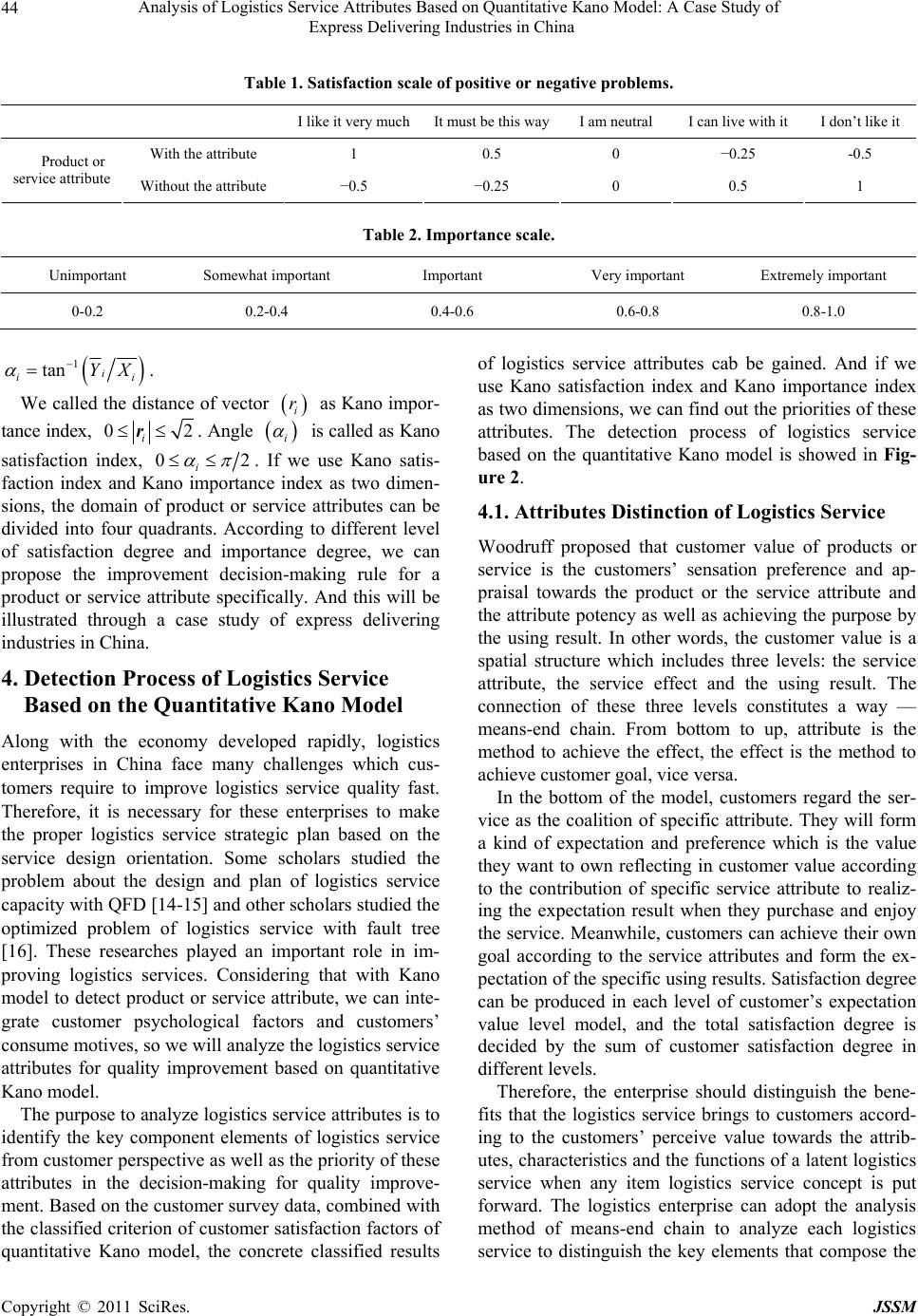 Analysis of Logistics Service Attributes Based on Quantitative Kano Model: A Case Study of Express Delivering Industries in China Copyright © 2011 SciRes. JSSM 44 Table 1. Satisfaction scale of positive or negative problems. I like it very muchIt must be this wayI am neutral I can live with it I don’t like it With the attribute 1 0.5 0 −0.25 -0.5 Product or service attribute Without the attribute −0.5 −0.25 0 0.5 1 Table 2. Importance scale. Unimportant Somewhat important Important Very important Extremely important 0-0.2 0.2-0.4 0.4-0.6 0.6-0.8 0.8-1.0 1 tan i ii YX . We called the distance of vector as Kano impor- i r tance index, 0 i r2. Angle is called as Kano i satisfaction index, 0 i2 . If we use Kano satis- faction index and Kano importance index as two dimen- sions, the domain of product or service attributes can be divided into four quadrants. According to different level of satisfaction degree and importance degree, we can propose the improvement decision-making rule for a product or service attribute specifically. And this will be illustrated through a case study of express delivering industries in China. 4. Detection Process of Logistics Service Based on the Quantitative Kano Model Along with the economy developed rapidly, logistics enterprises in China face many challenges which cus- tomers require to improve logistics service quality fast. Therefore, it is necessary for these enterprises to make the proper logistics service strategic plan based on the service design orientation. Some scholars studied the problem about the design and plan of logistics service capacity with QFD [14-15] and other scholars studied the optimized problem of logistics service with fault tree [16]. These researches played an important role in im- proving logistics services. Considering that with Kano model to detect product or service attribute, we can inte- grate customer psychological factors and customers’ consume motives, so we will analyze the logistics service attributes for quality improvement based on quantitative Kano model. The purpose to analyze logistics service attributes is to identify the key component elements of logistics service from customer perspective as well as the priority of these attributes in the decision-making for quality improve- ment. Based on the customer survey data, combined with the classified criterion of customer satisfaction factors of quantitative Kano model, the concrete classified results of logistics service attributes cab be gained. And if we use Kano satisfaction index and Kano importance index as two dimensions, we can find out the priorities of these attributes. The detection process of logistics service based on the quantitative Kano model is showed in Fig- ure 2. 4.1. Attributes Distinction of Logistics Service Woodruff proposed that customer value of products or service is the customers’ sensation preference and ap- praisal towards the product or the service attribute and the attribute potency as well as achieving the purpose by the using result. In other words, the customer value is a spatial structure which includes three levels: the service attribute, the service effect and the using result. The connection of these three levels constitutes a way — means-end chain. From bottom to up, attribute is the method to achieve the effect, the effect is the method to achieve customer goal, vice versa. In the bottom of the model, customers regard the ser- vice as the coalition of specific attribute. They will form a kind of expectation and preference which is the value they want to own reflecting in customer value according to the contribution of specific service attribute to realiz- ing the expectation result when they purchase and enjoy the service. Meanwhile, customers can achieve their own goal according to the service attributes and form the ex- pectation of the specific using results. Satisfaction degree can be produced in each level of customer’s expectation value level model, and the total satisfaction degree is decided by the sum of customer satisfaction degree in different levels. Therefore, the enterprise should distinguish the bene- fits that the logistics service brings to customers accord- ing to the customers’ perceive value towards the attrib- utes, characteristics and the functions of a latent logistics service when any item logistics service concept is put forward. The logistics enterprise can adopt the analysis method of means-end chain to analyze each logistics service to distinguish the key elements that compose the 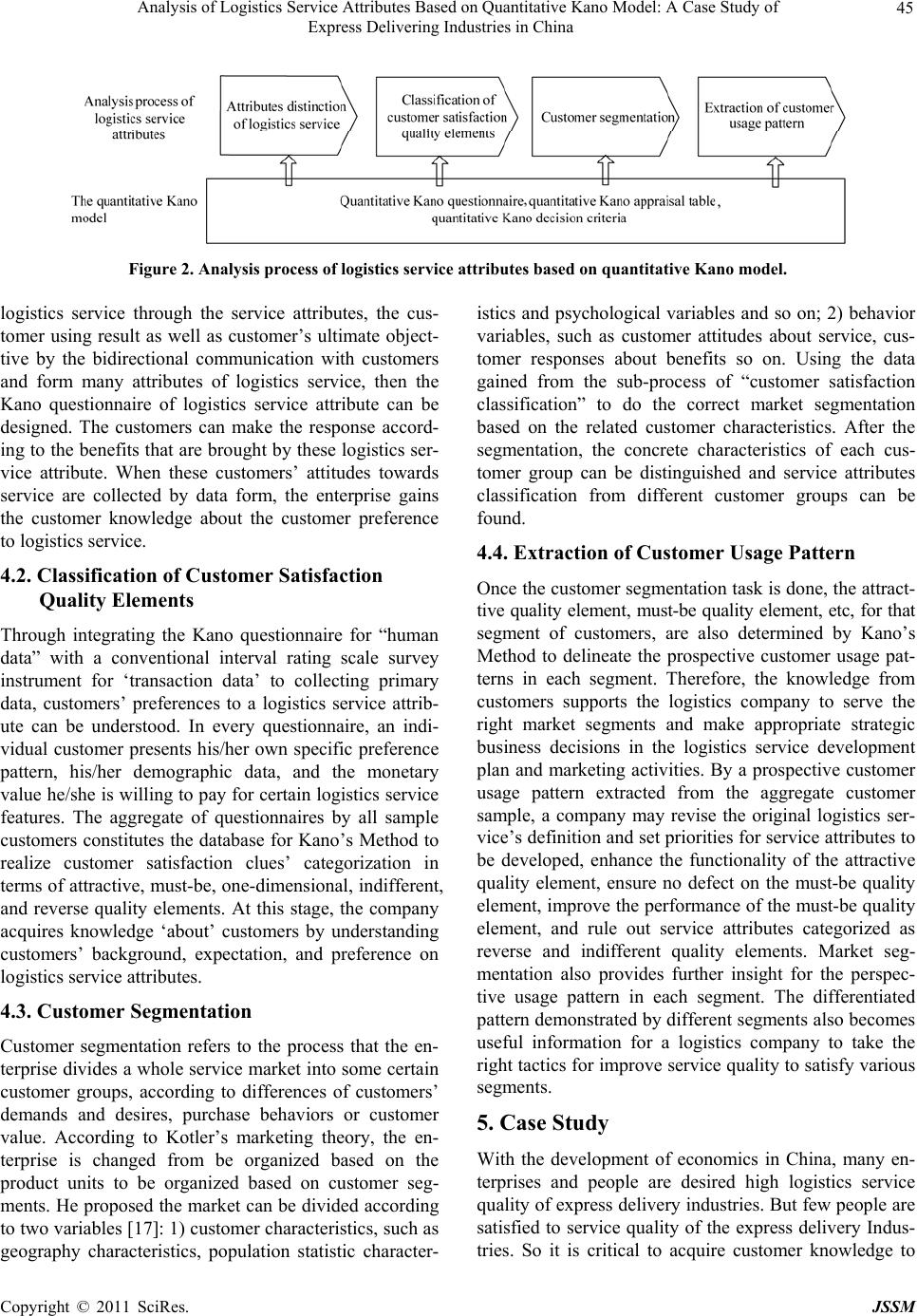 Analysis of Logistics Service Attributes Based on Quantitative Kano Model: A Case Study of Express Delivering Industries in China 45 Figure 2. Analysis process of logistics service attributes based on quantitative Kano model. logistics service through the service attributes, the cus- tomer using result as well as customer’s ultimate object- tive by the bidirectional communication with customers and form many attributes of logistics service, then the Kano questionnaire of logistics service attribute can be designed. The customers can make the response accord- ing to the benefits that are brought by these logistics ser- vice attribute. When these customers’ attitudes towards service are collected by data form, the enterprise gains the customer knowledge about the customer preference to logistics service. 4.2. Classification of Customer Satisfaction Quality Elements Through integrating the Kano questionnaire for “human data” with a conventional interval rating scale survey instrument for ‘transaction data’ to collecting primary data, customers’ preferences to a logistics service attrib- ute can be understood. In every questionnaire, an indi- vidual customer presents his/her own specific preference pattern, his/her demographic data, and the monetary value he/she is willing to pay for certain logistics service features. The aggregate of questionnaires by all sample customers constitutes the database for Kano’s Method to realize customer satisfaction clues’ categorization in terms of attractive, must-be, one-dimensional, indifferent, and reverse quality elements. At this stage, the company acquires knowledge ‘about’ customers by understanding customers’ background, expectation, and preference on logistics service attributes. 4.3. Customer Segmentation Customer segmentation refers to the process that the en- terprise divides a whole service market into some certain customer groups, according to differences of customers’ demands and desires, purchase behaviors or customer value. According to Kotler’s marketing theory, the en- terprise is changed from be organized based on the product units to be organized based on customer seg- ments. He proposed the market can be divided according to two variables [17]: 1) customer characteristics, such as geography characteristics, population statistic character- istics and psychological variables and so on; 2) behavior variables, such as customer attitudes about service, cus- tomer responses about benefits so on. Using the data gained from the sub-process of “customer satisfaction classification” to do the correct market segmentation based on the related customer characteristics. After the segmentation, the concrete characteristics of each cus- tomer group can be distinguished and service attributes classification from different customer groups can be found. 4.4. Extraction of Customer Usage Pattern Once the customer segmentation task is done, the attract- tive quality element, must-be quality element, etc, for that segment of customers, are also determined by Kano’s Method to delineate the prospective customer usage pat- terns in each segment. Therefore, the knowledge from customers supports the logistics company to serve the right market segments and make appropriate strategic business decisions in the logistics service development plan and marketing activities. By a prospective customer usage pattern extracted from the aggregate customer sample, a company may revise the original logistics ser- vice’s definition and set priorities for service attributes to be developed, enhance the functionality of the attractive quality element, ensure no defect on the must-be quality element, improve the performance of the must-be quality element, and rule out service attributes categorized as reverse and indifferent quality elements. Market seg- mentation also provides further insight for the perspec- tive usage pattern in each segment. The differentiated pattern demonstrated by different segments also becomes useful information for a logistics company to take the right tactics for improve service quality to satisfy various segments. 5. Case Study With the development of economics in China, many en- terprises and people are desired high logistics service quality of express delivery industries. But few people are satisfied to service quality of the express delivery Indus- tries. So it is critical to acquire customer knowledge to Copyright © 2011 SciRes. JSSM 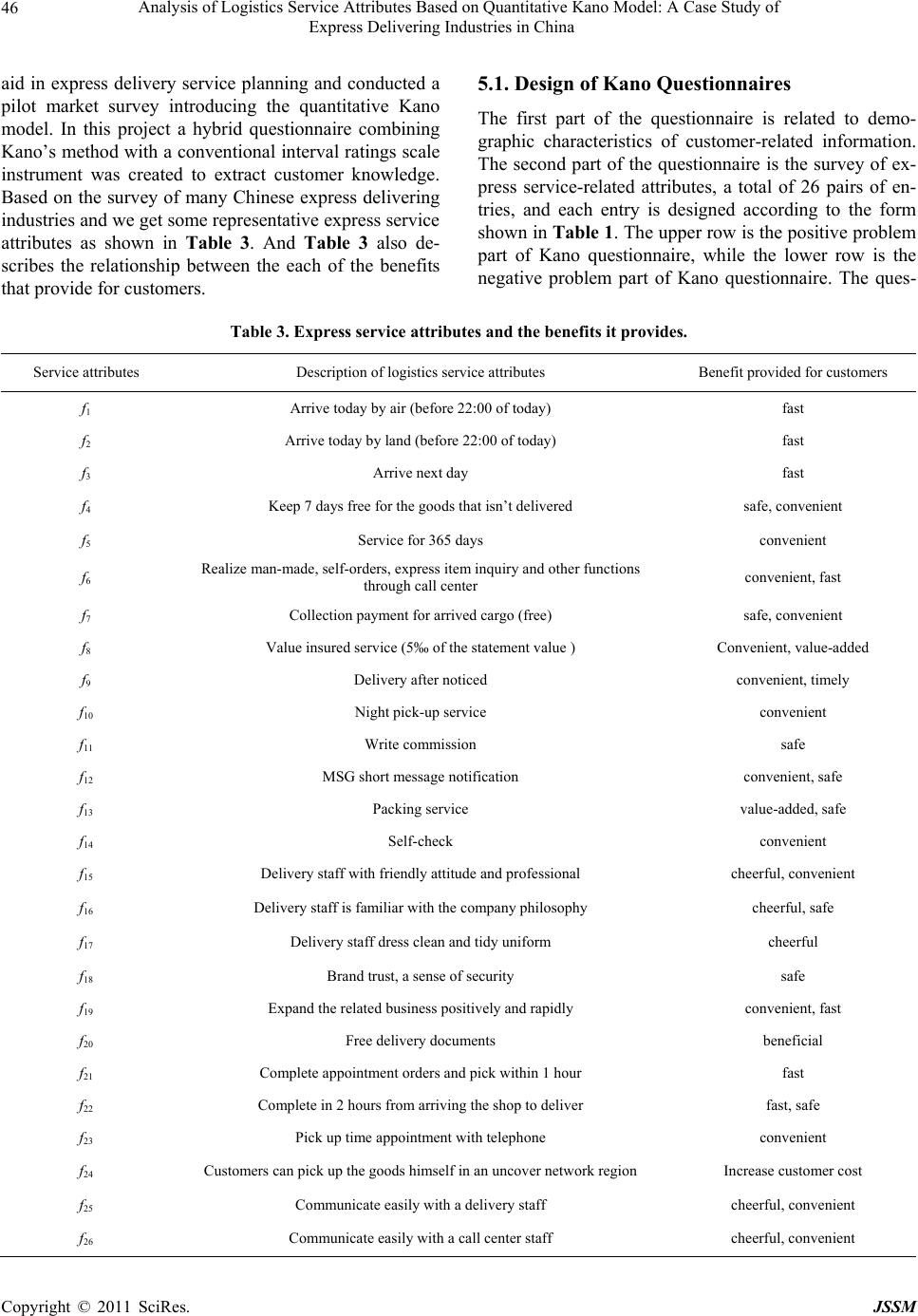 Analysis of Logistics Service Attributes Based on Quantitative Kano Model: A Case Study of 46 Express Delivering Industries in China aid in express delivery service planning and conducted a pilot market survey introducing the quantitative Kano model. In this project a hybrid questionnaire combining Kano’s method with a conventional interval ratings scale instrument was created to extract customer knowledge. Based on the survey of many Chinese express delivering industries and we get some representative express service attributes as shown in Table 3. And Table 3 also de- scribes the relationship between the each of the benefits that provide for customers. 5.1. Design of Kano Questionnaires The first part of the questionnaire is related to demo- graphic characteristics of customer-related information. The second part of the questionnaire is the survey of ex- press service-related attributes, a total of 26 pairs of en- tries, and each entry is designed according to the form shown in Table 1 . The upper row is the positive problem part of Kano questionnaire, while the lower row is the negative problem part of Kano questionnaire. The ques- Table 3. Express service attributes and the benefits it provides. Service attributes Description of logistics service attributes Benefit provided for customers f1 Arrive today by air (before 22:00 of today) fast f2 Arrive today by land (before 22:00 of today) fast f3 Arrive next day fast f4 Keep 7 days free for the goods that isn’t delivered safe, convenient f5 Service for 365 days convenient f6 Realize man-made, self-orders, express item inquiry and other functions through call center convenient, fast f7 Collection payment for arrived cargo (free) safe, convenient f8 Value insured service (5‰ of the statement value ) Convenient, value-added f9 Delivery after noticed convenient, timely f10 Night pick-up service convenient f11 Write commission safe f12 MSG short message notification convenient, safe f13 Packing service value-added, safe f14 Self-check convenient f15 Delivery staff with friendly attitude and professional cheerful, convenient f16 Delivery staff is familiar with the company philosophy cheerful, safe f17 Delivery staff dress clean and tidy uniform cheerful f18 Brand trust, a sense of security safe f19 Expand the related business positively and rapidly convenient, fast f20 Free delivery documents beneficial f21 Complete appointment orders and pick within 1 hour fast f22 Complete in 2 hours from arriving the shop to deliver fast, safe f23 Pick up time appointment with telephone convenient f24 Customers can pick up the goods himself in an uncover network region Increase customer cost f25 Communicate easily with a delivery staff cheerful, convenient f26 Communicate easily with a call center staff cheerful, convenient Copyright © 2011 SciRes. JSSM 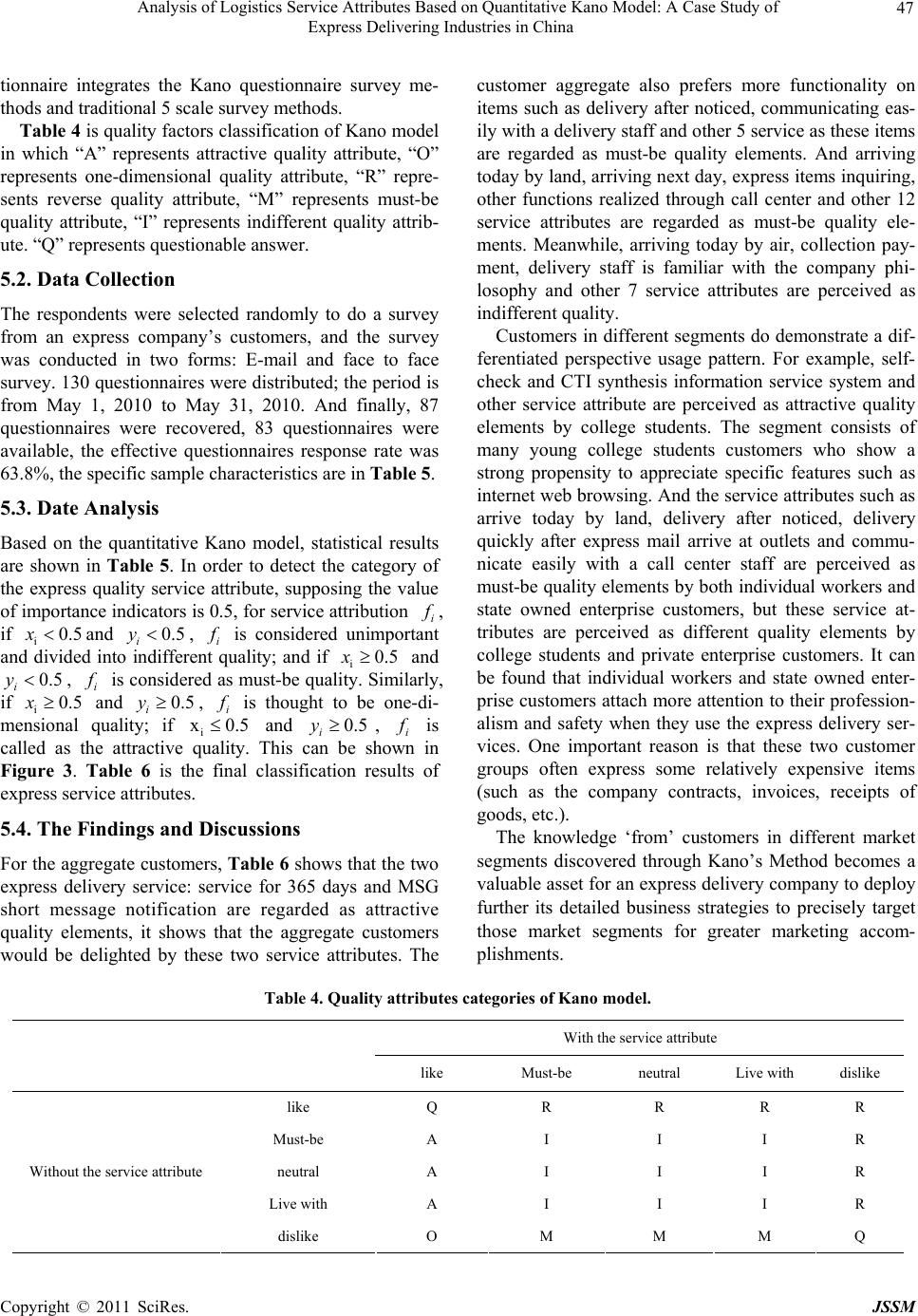 Analysis of Logistics Service Attributes Based on Quantitative Kano Model: A Case Study of Express Delivering Industries in China 47 tionnaire integrates the Kano questionnaire survey me- thods and traditional 5 scale survey methods. Table 4 is quality factors classification of Kano model in which “A” represents attractive quality attribute, “O” represents one-dimensional quality attribute, “R” repre- sents reverse quality attribute, “M” represents must-be quality attribute, “I” represents indifferent quality attrib- ute. “Q” represents questionable answer. 5.2. Data Collection The respondents were selected randomly to do a survey from an express company’s customers, and the survey was conducted in two forms: E-mail and face to face survey. 130 questionnaires were distributed; the period is from May 1, 2010 to May 31, 2010. And finally, 87 questionnaires were recovered, 83 questionnaires were available, the effective questionnaires response rate was 63.8%, the specific sample characteristics are in Table 5. 5.3. Date Analysis Based on the quantitative Kano model, statistical results are shown in Table 5. In order to detect the category of the express quality service attribute, supposing the value of importance indicators is 0.5, for service attribution i , if iand , i 0.5x0.5 i y is considered unimportant and divided into indifferent quality; and if i and i, i 0.5x 0.5 y is considered as must-be quality. Similarly, if i and , 0.5x0.5 i yi is thought to be one-di- mensional quality; if i and i, i x0.5 0.5y is called as the attractive quality. This can be shown in Figure 3. Table 6 is the final classification results of express service attributes. 5.4. The Findings and Discussions For the aggregate customers, Table 6 shows that the two express delivery service: service for 365 days and MSG short message notification are regarded as attractive quality elements, it shows that the aggregate customers would be delighted by these two service attributes. The customer aggregate also prefers more functionality on items such as delivery after noticed, communicating eas- ily with a delivery staff and other 5 service as these items are regarded as must-be quality elements. And arriving today by land, arriving next day, express items inquiring, other functions realized through call center and other 12 service attributes are regarded as must-be quality ele- ments. Meanwhile, arriving today by air, collection pay- ment, delivery staff is familiar with the company phi- losophy and other 7 service attributes are perceived as indifferent quality. Customers in different segments do demonstrate a dif- ferentiated perspective usage pattern. For example, self- check and CTI synthesis information service system and other service attribute are perceived as attractive quality elements by college students. The segment consists of many young college students customers who show a strong propensity to appreciate specific features such as internet web browsing. And the service attributes such as arrive today by land, delivery after noticed, delivery quickly after express mail arrive at outlets and commu- nicate easily with a call center staff are perceived as must-be quality elements by both individual workers and state owned enterprise customers, but these service at- tributes are perceived as different quality elements by college students and private enterprise customers. It can be found that individual workers and state owned enter- prise customers attach more attention to their profession- alism and safety when they use the express delivery ser- vices. One important reason is that these two customer groups often express some relatively expensive items (such as the company contracts, invoices, receipts of goods, etc.). The knowledge ‘from’ customers in different market segments discovered through Kano’s Method becomes a valuable asset for an express delivery company to deploy further its detailed business strategies to precisely target those market segments for greater marketing accom- plishments. Table 4. Quality attributes categories of Kano model. With the service attribute like Must-be neutral Live with dislike like Q R R R R Must-be A I I I R neutral A I I I R Live with A I I I R Without the service attribute dislike O M M M Q Copyright © 2011 SciRes. JSSM 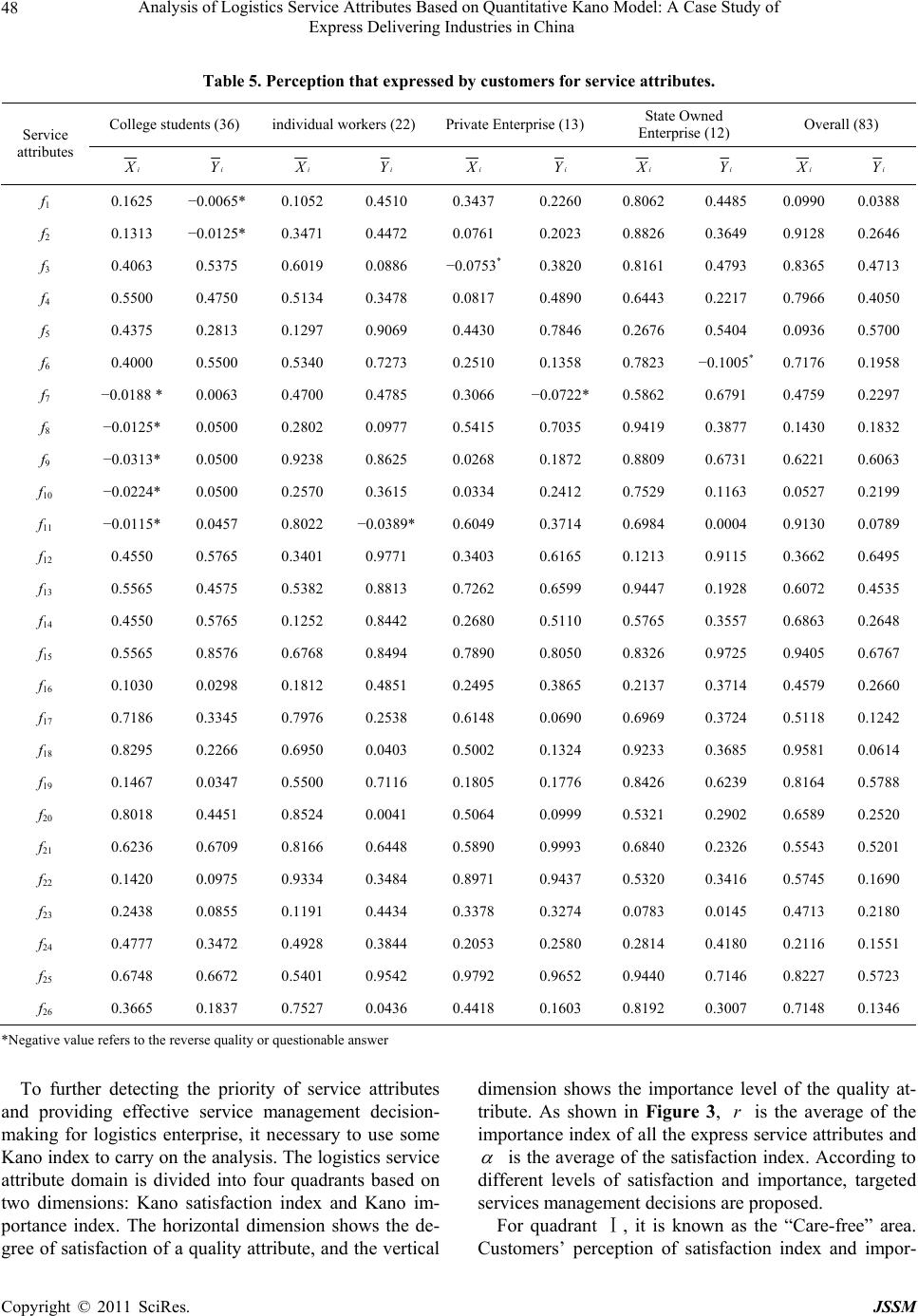 Analysis of Logistics Service Attributes Based on Quantitative Kano Model: A Case Study of 48 Express Delivering Industries in China Table 5. Perception that expressed by customers for service attributes. College students (36) individual workers (22)Private Enterprise (13) State Owned Enterprise (12) Overall (83) Service attributes i X i Y i X i Y i X i Y i X i Y i X i Y f1 0.1625 −0.0065* 0.1052 0.4510 0.3437 0.2260 0.8062 0.4485 0.0990 0.0388 f2 0.1313 −0.0125* 0.3471 0.4472 0.0761 0.2023 0.8826 0.3649 0.9128 0.2646 f3 0.4063 0.5375 0.6019 0.0886 −0.0753* 0.3820 0.8161 0.4793 0.8365 0.4713 f4 0.5500 0.4750 0.5134 0.3478 0.0817 0.4890 0.6443 0.2217 0.7966 0.4050 f5 0.4375 0.2813 0.1297 0.9069 0.4430 0.7846 0.2676 0.5404 0.0936 0.5700 f6 0.4000 0.5500 0.5340 0.7273 0.2510 0.1358 0.7823 −0.1005* 0.7176 0.1958 f7 −0.0188 * 0.0063 0.4700 0.4785 0.3066 −0.0722*0.5862 0.6791 0.4759 0.2297 f8 −0.0125* 0.0500 0.2802 0.0977 0.5415 0.7035 0.9419 0.3877 0.1430 0.1832 f9 −0.0313* 0.0500 0.9238 0.8625 0.0268 0.1872 0.8809 0.6731 0.6221 0.6063 f10 −0.0224* 0.0500 0.2570 0.3615 0.0334 0.2412 0.7529 0.1163 0.0527 0.2199 f11 −0.0115* 0.0457 0.8022 −0.0389*0.6049 0.3714 0.6984 0.0004 0.9130 0.0789 f12 0.4550 0.5765 0.3401 0.9771 0.3403 0.6165 0.1213 0.9115 0.3662 0.6495 f13 0.5565 0.4575 0.5382 0.8813 0.7262 0.6599 0.9447 0.1928 0.6072 0.4535 f14 0.4550 0.5765 0.1252 0.8442 0.2680 0.5110 0.5765 0.3557 0.6863 0.2648 f15 0.5565 0.8576 0.6768 0.8494 0.7890 0.8050 0.8326 0.9725 0.9405 0.6767 f16 0.1030 0.0298 0.1812 0.4851 0.2495 0.3865 0.2137 0.3714 0.4579 0.2660 f17 0.7186 0.3345 0.7976 0.2538 0.6148 0.0690 0.6969 0.3724 0.5118 0.1242 f18 0.8295 0.2266 0.6950 0.0403 0.5002 0.1324 0.9233 0.3685 0.9581 0.0614 f19 0.1467 0.0347 0.5500 0.7116 0.1805 0.1776 0.8426 0.6239 0.8164 0.5788 f20 0.8018 0.4451 0.8524 0.0041 0.5064 0.0999 0.5321 0.2902 0.6589 0.2520 f21 0.6236 0.6709 0.8166 0.6448 0.5890 0.9993 0.6840 0.2326 0.5543 0.5201 f22 0.1420 0.0975 0.9334 0.3484 0.8971 0.9437 0.5320 0.3416 0.5745 0.1690 f23 0.2438 0.0855 0.1191 0.4434 0.3378 0.3274 0.0783 0.0145 0.4713 0.2180 f24 0.4777 0.3472 0.4928 0.3844 0.2053 0.2580 0.2814 0.4180 0.2116 0.1551 f25 0.6748 0.6672 0.5401 0.9542 0.9792 0.9652 0.9440 0.7146 0.8227 0.5723 f26 0.3665 0.1837 0.7527 0.0436 0.4418 0.1603 0.8192 0.3007 0.7148 0.1346 *Negative value refers to the reverse quality or questionable answer To further detecting the priority of service attributes and providing effective service management decision- making for logistics enterprise, it necessary to use some Kano index to carry on the analysis. The logistics service attribute domain is divided into four quadrants based on two dimensions: Kano satisfaction index and Kano im- portance index. The horizontal dimension shows the de- gree of satisfaction of a quality attribute, and the vertical dimension shows the importance level of the quality at- tribute. As shown in Figure 3, is the average of the r importance index of all the express service attributes and is the average of the satisfaction index. According to different levels of satisfaction and importance, targeted services management decisions are proposed. For quadrant , it is known as the Ⅰ“Care-free” area. C ustomers’ perception of satisfaction index and impor- Copyright © 2011 SciRes. JSSM 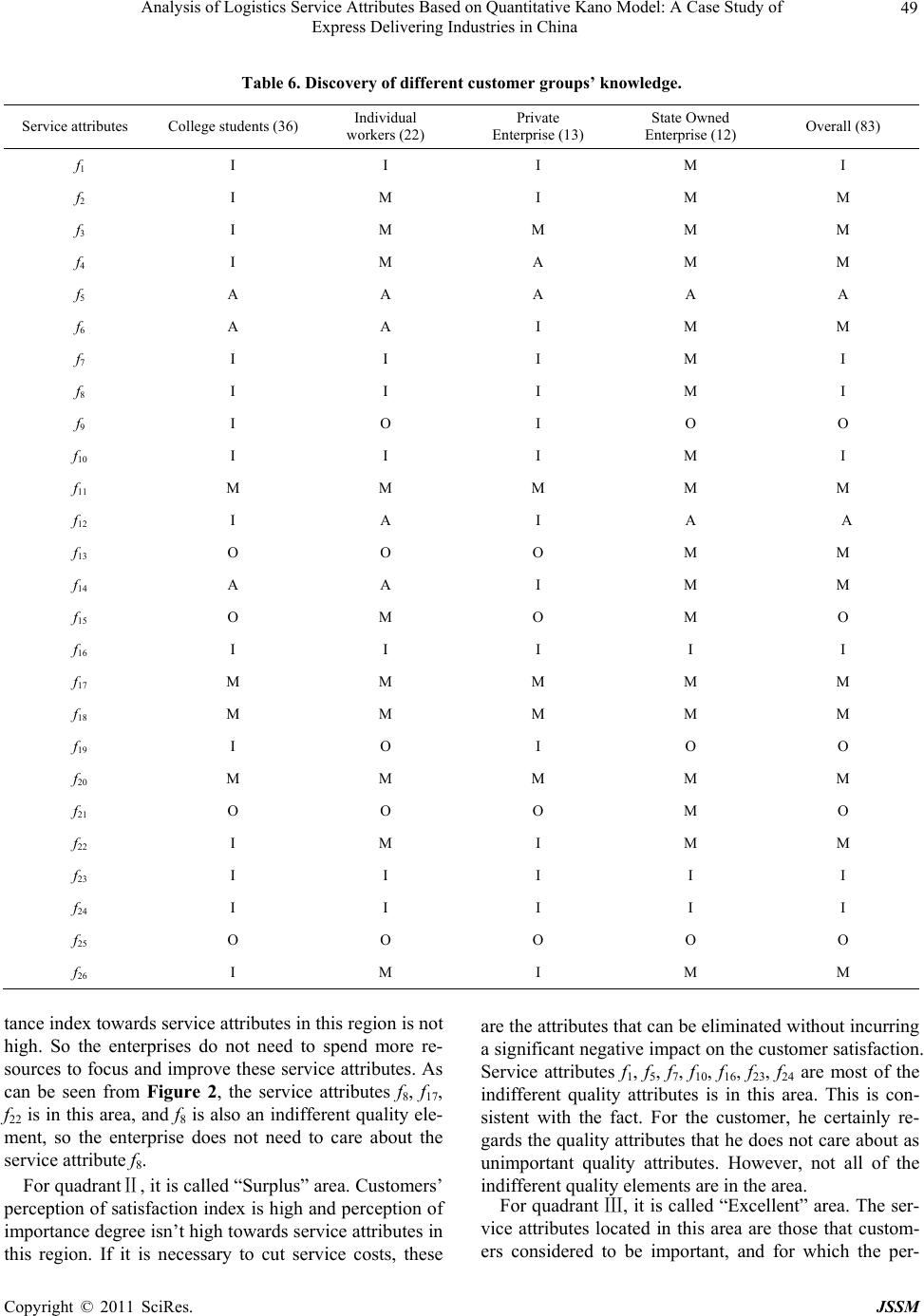 Analysis of Logistics Service Attributes Based on Quantitative Kano Model: A Case Study of Express Delivering Industries in China 49 Table 6. Discovery of different customer groups’ knowledge. Service attributes College students (36) Individual workers (22) Private Enterprise (13) State Owned Enterprise (12) Overall (83) f1 I I I M I f2 I M I M M f3 I M M M M f4 I M A M M f5 A A A A A f6 A A I M M f7 I I I M I f8 I I I M I f9 I O I O O f10 I I I M I f11 M M M M M f12 I A I A A f13 O O O M M f14 A A I M M f15 O M O M O f16 I I I I I f17 M M M M M f18 M M M M M f19 I O I O O f20 M M M M M f21 O O O M O f22 I M I M M f23 I I I I I f24 I I I I I f25 O O O O O f26 I M I M M tance index towards service attributes in this region is not high. So the enterprises do not need to spend more re- sources to focus and improve these service attributes. As can be seen from Figure 2, the service attributes f8, f17, f22 is in this area, and f8 is also an indifferent quality ele- ment, so the enterprise does not need to care about the service attribute f8. For quadrantⅡ, it is called “Surplus” area. Customers’ perception of satisfaction index is high and perception of importance degree isn’t high towards service attributes in this region. If it is necessary to cut service costs, these are the attributes that can be eliminated without incurring a significant negative impact on the customer satisfaction. Service attributes f1, f5, f7, f10, f16, f23, f24 are most of the indifferent quality attributes is in this area. This is con- sistent with the fact. For the customer, he certainly re- gards the quality attributes that he does not care about as unimportant quality attributes. However, not all of the indifferent quality elements are in the area. For quadrant Ⅲ, it is called “Excellent” area. The ser- vice attributes located in this area are those that custom- ers considered to be important, and for which the per- Copyright © 2011 SciRes. JSSM 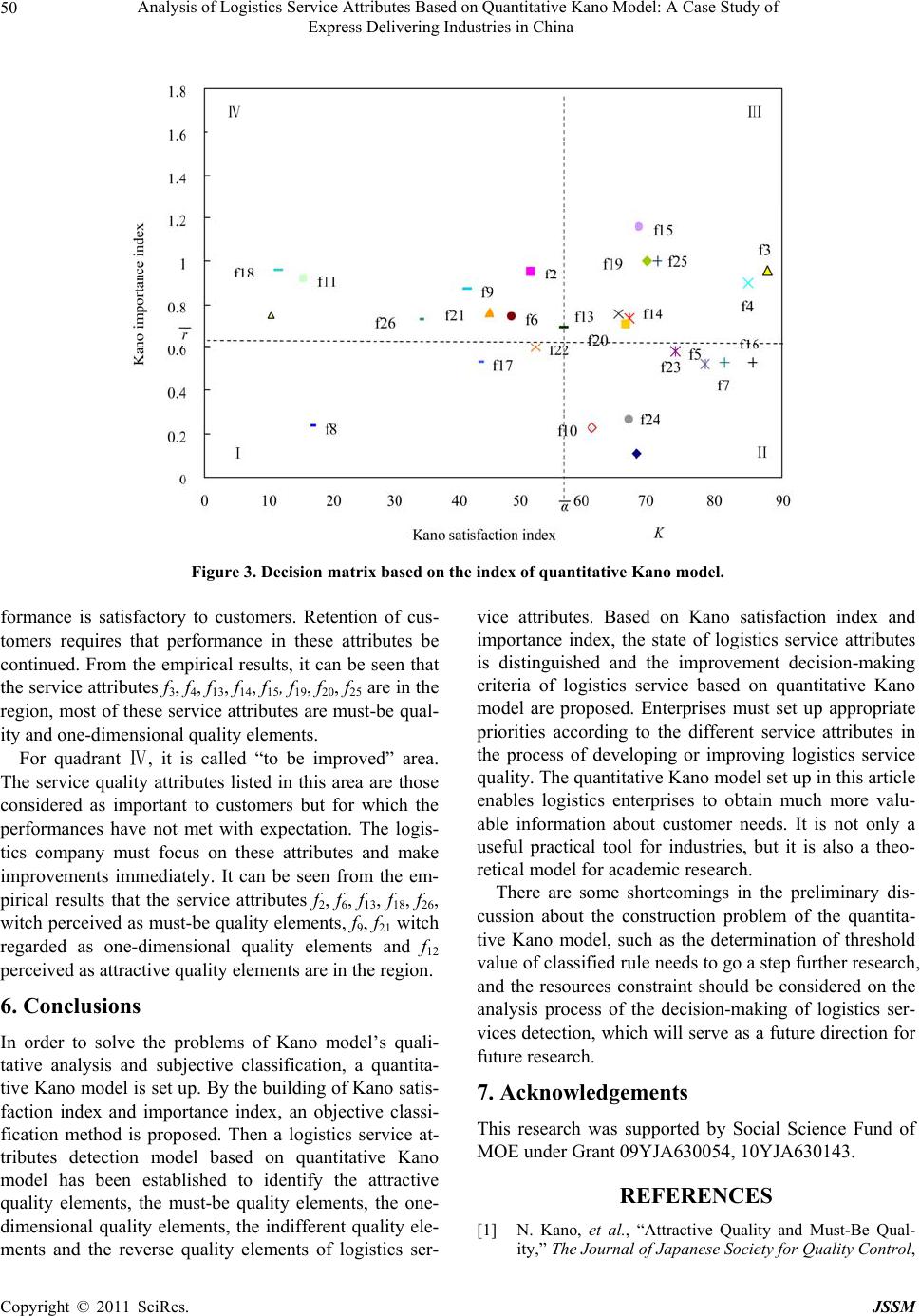 Analysis of Logistics Service Attributes Based on Quantitative Kano Model: A Case Study of 50 Express Delivering Industries in China Figure 3. Decision matrix based on the index of quantitative Kano model. formance is satisfactory to customers. Retention of cus- tomers requires that performance in these attributes be continued. From the empirical results, it can be seen that the service attributes f3, f4, f13, f14, f15, f19, f20, f25 are in the region, most of these service attributes are must-be qual- ity and one-dimensional quality elements. For quadrant Ⅳ, it is called “to be improved” area. The service quality attributes listed in this area are those considered as important to customers but for which the performances have not met with expectation. The logis- tics company must focus on these attributes and make improvements immediately. It can be seen from the em- pirical results that the service attributes f2, f6, f13, f18, f26, witch perceived as must-be quality elements, f9, f21 witch regarded as one-dimensional quality elements and f12 perceived as attractive quality elements are in the region. 6. Conclusions In order to solve the problems of Kano model’s quali- tative analysis and subjective classification, a quantita- tive Kano model is set up. By the building of Kano satis- faction index and importance index, an objective classi- fication method is proposed. Then a logistics service at- tributes detection model based on quantitative Kano model has been established to identify the attractive quality elements, the must-be quality elements, the one- dimensional quality elements, the indifferent quality ele- ments and the reverse quality elements of logistics ser- vice attributes. Based on Kano satisfaction index and importance index, the state of logistics service attributes is distinguished and the improvement decision-making criteria of logistics service based on quantitative Kano model are proposed. Enterprises must set up appropriate priorities according to the different service attributes in the process of developing or improving logistics service quality. The quantitative Kano model set up in this article enables logistics enterprises to obtain much more valu- able information about customer needs. It is not only a useful practical tool for industries, but it is also a theo- retical model for academic research. There are some shortcomings in the preliminary dis- cussion about the construction problem of the quantita- tive Kano model, such as the determination of threshold value of classified rule needs to go a step further research, and the resources constraint should be considered on the analysis process of the decision-making of logistics ser- vices detection, which will serve as a future direction for future research. 7. Acknowledgements This research was supported by Social Science Fund of MOE under Grant 09YJA630054, 10YJA630143. REFERENCES [1] N. Kano, et al., “Attractive Quality and Must-Be Qual- ity,” The Journal of Japanese Society for Quality Control, Copyright © 2011 SciRes. JSSM 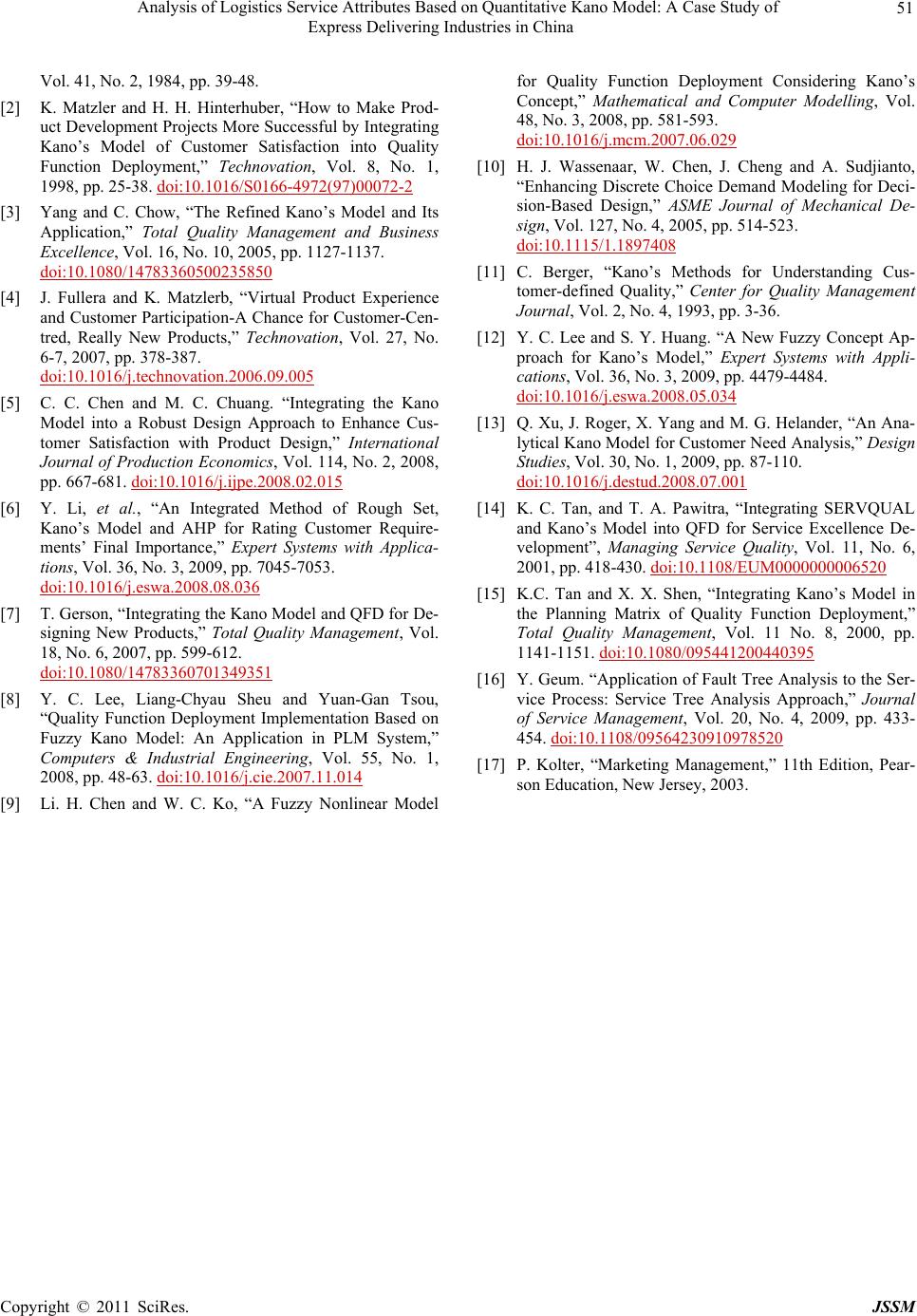 Analysis of Logistics Service Attributes Based on Quantitative Kano Model: A Case Study of Express Delivering Industries in China 51 Vol. 41, No. 2, 1984, pp. 39-48. [2] K. Matzler and H. H. Hinterhuber, “How to Make Prod- uct Development Projects More Successful by Integrating Kano’s Model of Customer Satisfaction into Quality Function Deployment,” Technovation, Vol. 8, No. 1, 1998, pp. 25-38. doi:10.1016/S0166-4972(97)00072-2 [3] Yang and C. Chow, “The Refined Kano’s Model and Its Application,” Total Quality Management and Business Excellence, Vol. 16, No. 10, 2005, pp. 1127-1137. doi:10.1080/14783360500235850 [4] J. Fullera and K. Matzlerb, “Virtual Product Experience and Customer Participation-A Chance for Customer-Cen- tred, Really New Products,” Technovation, Vol. 27, No. 6-7, 2007, pp. 378-387. doi:10.1016/j.technovation.2006.09.005 [5] C. C. Chen and M. C. Chuang. “Integrating the Kano Model into a Robust Design Approach to Enhance Cus- tomer Satisfaction with Product Design,” International Journal of Production Economics, Vol. 114, No. 2, 2008, pp. 667-681. doi:10.1016/j.ijpe.2008.02.015 [6] Y. Li, et al., “An Integrated Method of Rough Set, Kano’s Model and AHP for Rating Customer Require- ments’ Final Importance,” Expert Systems with Applica- tions, Vol. 36, No. 3, 2009, pp. 7045-7053. doi:10.1016/j.eswa.2008.08.036 [7] T. Gerson, “Integrating the Kano Model and QFD for De- signing New Products,” Total Quality Management, Vol. 18, No. 6, 2007, pp. 599-612. doi:10.1080/14783360701349351 [8] Y. C. Lee, Liang-Chyau Sheu and Yuan-Gan Tsou, “Quality Function Deployment Implementation Based on Fuzzy Kano Model: An Application in PLM System,” Computers & Industrial Engineering, Vol. 55, No. 1, 2008, pp. 48-63. doi:10.1016/j.cie.2007.11.014 [9] Li. H. Chen and W. C. Ko, “A Fuzzy Nonlinear Model for Quality Function Deployment Considering Kano’s Concept,” Mathematical and Computer Modelling, Vol. 48, No. 3, 2008, pp. 581-593. doi:10.1016/j.mcm.2007.06.029 [10] H. J. Wassenaar, W. Chen, J. Cheng and A. Sudjianto, “Enhancing Discrete Choice Demand Modeling for Deci- sion-Based Design,” ASME Journal of Mechanical De- sign, Vol. 127, No. 4, 2005, pp. 514-523. doi:10.1115/1.1897408 [11] C. Berger, “Kano’s Methods for Understanding Cus- tomer-defined Quality,” Center for Quality Management Journal, Vol. 2, No. 4, 1993, pp. 3-36. [12] Y. C. Lee and S. Y. Huang. “A New Fuzzy Concept Ap- proach for Kano’s Model,” Expert Systems with Appli- cations, Vol. 36, No. 3, 2009, pp. 4479-4484. doi:10.1016/j.eswa.2008.05.034 [13] Q. Xu, J. Roger, X. Yang and M. G. Helander, “An Ana- lytical Kano Model for Customer Need Analysis,” Design Studies, Vol. 30, No. 1, 2009, pp. 87-110. doi:10.1016/j.destud.2008.07.001 [14] K. C. Tan, and T. A. Pawitra, “Integrating SERVQUAL and Kano’s Model into QFD for Service Excellence De- velopment”, Managing Service Quality, Vol. 11, No. 6, 2001, pp. 418-430. doi:10.1108/EUM0000000006520 [15] K.C. Tan and X. X. Shen, “Integrating Kano’s Model in the Planning Matrix of Quality Function Deployment,” Total Quality Management, Vol. 11 No. 8, 2000, pp. 1141-1151. doi:10.1080/095441200440395 [16] Y. Geum. “Application of Fault Tree Analysis to the Ser- vice Process: Service Tree Analysis Approach,” Journal of Service Management, Vol. 20, No. 4, 2009, pp. 433- 454. doi:10.1108/09564230910978520 [17] P. Kolter, “Marketing Management,” 11th Edition, Pear- son Education, New Jersey, 2003. Copyright © 2011 SciRes. JSSM
|